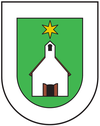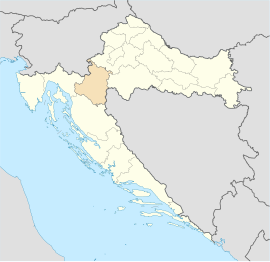Saborsko
| Saborsko | ||
|
||
|
|
||
| Basic data | ||
|---|---|---|
| State : |
|
|
| County : |
|
|
| Residents : | 632 (2011) | |
| Telephone code : | (+385) 047 | |
| Postal code : | 47 306 | |
| License plate : | 1st floor | |
| Structure and administration (status: 2013, cf. ) |
||
| Community type : | local community | |
| Mayor : | Marko Bićanić ( HDZ ) | |
| Website : | ||
Saborsko (formerly Zaborsko ) is a municipality in the hilly area of central Croatia near Ogulin .
geography
Saborsko is a mountain village that is located on sloping slopes and in a long and narrow basin. In fact, it is probably the longest-spanning village in Croatia. The distance between the entrance to the village from Plaški and the other end at Kuselj near the Plitvice Lakes is 8.7 km. If one also includes the village of Sertić-Poljana , which was actually always considered to be separate from Saborsko, the village would extend over a total of 12 km. A quarter of the municipal area of Saborsko is part of the Plitvice Lakes National Park .
population
Ethnic groups (2011 census):
In 1959, 81 children were baptized in the village. 1969 only 26. 1979 only 10 children and 1990 only five children. In 1974 the parish had 1701 (-187) inhabitants.
The remaining population was also displaced by the Croatian war . In 2003 seven children were baptized in the parish.
history
Saborsko is first mentioned in written sources in the Modrušer Urbar (Croatian Modruški urbar ) 1486 as one of the places that came into the possession of the Croatian ban Stjepan Frankopan II. Ozaljski in 1449 . The village also existed before. However, it is very likely that Frankopan deliberately settled people in the village after the Modruš County came into his possession at the end of the 12th century .
From the land register it can be seen that there was a Catholic parish with a church in Saborsko, and that the serfs had to work on the ecclesiastical property in addition to the fief of the nobility. Nevertheless, in view of the Turkish invasions, the village was soon abandoned, even if there are views that Saborsko was never completely evacuated.
The residents and their pets hid in the deep forests from the Ottomans . When the Plaški plain (Croatian: Plaščanska dolina ) was repopulated with Wallachian Orthodox believers, the Croatian Catholics who had fled to Carniola returned. Therefore, the village has remained a predominantly Croatian settlement to this day.
Parish of Saborsko
The Saborsko parish is a parish of returnees. During the Croatian War , the defenders of Saborsko had to withdraw after several months. The village, as well as all the houses, including the parish church, were destroyed by Serbian militants . The remaining elderly population was killed and thrown into a mass grave near the rectory.
The archbishop of Rijeka-Senj Antun Tamarot presided over the funeral ceremonies four years after this event, which took place on November 12, 1991 . The ceremonies took place on November 15, 1995. The remains of the dead Saborsko residents were buried in the municipal cemetery.
In the death register there are also 16 more people who died in the war in Croatia, a total of 40 people from the parish of Saborsko.
The return to Saborsko was slow. All houses had been destroyed, there was unemployment and there was a great danger of mines . Initially, only older people returned. The Croatian government committed itself to rebuilding the family houses and communal buildings, including the parish church. This created the conditions for a return. Yet there are only a small number of young families and even fewer children.
According to the list of blessed houses dated December 30 and 31, 2003, 465 Catholics lived in 181 houses in the Saborsko parish, some of them only temporarily. In the large, rebuilt school there are only 18 students, which is an increase of 100% compared to the previous year when there were only 9 students. After the liberation of Saborsko, the parish was headed from nearby Josipdol from 1995 to 1996 by Pastor Zlatko Sušić , once pastor of Saborsko. At that time, Father Tonči took care of the population. Pastor Zdenko Skender , who also headed the parish in Plaški , followed, and since August 2003 brother Slavko Antunović and brother Robert Jolić .
economy
The area is rich in forests. This is also the main indicator of the way of life of the Saborsko population, who mainly dealt with forest management. Before the Second World War, around 2,000 workers were employed in the forestry and sawmills.
After the war, the number of sawmills fell noticeably, which led to increased resettlement. Today there is a sawmill in operation in Saborsko, which employs around 20 people.
Web link
- Website of the municipality Croatian

